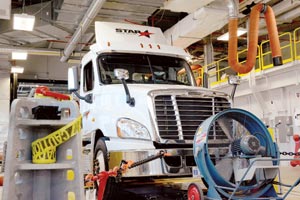More Scrutiny for Trucks Unlikely After Volkswagen’s Emissions Scandal

Trucking’s extensive experience with diesel-engine regulations could help mitigate any possible fallout against the industry in the wake of Volkswagen Group’s problems with the federal government concerning the automaker’s use of engine software that appears to have manipulated pollution controls.
While the U.S. Environmental Protection Agency has said it will step up its inspection of automakers using diesel engines, the regulators probably will treat carmakers as they have long treated truck makers, industry executives said.
Volkswagen’s current situation immediately was recognizable to veterans of trucking, because the industry went through similar issues in the late 1990s. That episode also involved “defeat devices” and led to an October 1998 federal consent decree.
“We are not authorities on how passenger cars are tested, but we can tell you that when it comes to heavy-duty trucks, EPA and [the California Air Resources Board] set specific limits on emissions when the vehicles are operating on the road,” Mack Trucks spokesman Christopher Heffner said.
“EPA issues annual test orders to manufacturers, which require us to use portable emission measurement equipment on customer trucks to demonstrate compliance to these limits in typical daily usage,” Heffner said.
“Cummins [Inc.] certifies its engines to EPA standards for the U.S. and Canada, or to the applicable standards in other regions of the world. We complete extensive validation of our products prior to launch,” company spokeswoman Carol Lavengood said.
“In addition, we perform in-use testing for on-highway engine-dyno certified engines,” she said.
Glen Kedzie, American Trucking Associations’ energy and environmental affairs counsel, noted that, from 2010 to 2013, heavy-duty truck engines phased in the use of onboard diagnostics to examine emissions of nitrogen oxide compounds and particulate matter.
Engines with OBD can derate performance, putting a truck into a slow-going limp mode if pollution controls are not functioning well, Kedzie said.
On Sept. 18, EPA and CARB officials sent letters to U.S.-based Volkswagen executives outlining their concerns. Volkswagen and Audi cars with 2-liter diesel engines have NOx-control systems, as do heavy trucks, but both regulators said the systems were programmed to work well while running on a testing dynamometer but much less thoroughly in highway mode.
“Emissions of NOx increased by a factor of 10 to 40 times above the EPA-compliant levels, depending on the type of drive cycle,” the EPA letter said.
Seventeen years ago, truck engine makers argued with EPA about the way their engines were programmed to perform. Seven manufacturers signed decrees that were announced by the U.S. attorney general and EPA administrator at the time.
Companies admitted to no wrongdoing but agreed to pay a combined $185 million in fines. The signing firms included Cummins, Volvo and Mack Trucks, Detroit Diesel Corp., Navistar International Corp. and Caterpillar Inc., which was then an independent engine maker.
Cummins’ Lavengood said the term defeat device is inappropriate for what happened in 1998.
“Cummins has never used a defeat device. . . . The emission control system was fully disclosed and approved by the EPA. Additionally, Cummins closed its consent decree in 2011 and has worked collaboratively and proactively with emission regulators globally to ensure emission standards are clear, appropriately stringent and enforceable,” she said.
“Regarding the dispute between the heavy-duty engine manufacturers and the EPA in the 1990s, our view is that there was a misunderstanding between the parties regarding the use of emissions controls,” Mack’s Heffner said.
As part of the decrees, engine makers also agreed to move up the next generation of NOx and particulate matter controls by 15 months to Oct. 1, 2002, from Jan. 1, 2004.
“The current situation is similar to the previous incident to the extent that there was a second ‘map,’ that they had not previously disclosed, that controlled the performance of the emission-control technology,” CARB spokesman Stanley Young said.
As for today, Young also said truck makers are watched carefully.
“Heavy-duty manufacturers have an in-use compliance requirement, and they have to submit data to show they are not exceeding a given standard. We, on our own, both EPA and CARB, do additional [portable emission-measurement systems], in-use compliance testing on [heavy-duty] trucks,” Young said.
An EPA official told the Associated Press that car-based problems were overlooked because of the agency’s focus on trucks.
“It’s a question of where we deploy those resources,” said Christopher Grundler, director of EPA’s Office of Transportation and Air Quality.
He said the agency has conducted on-road testing on heavy-duty trucks, rather than passenger cars, “because that’s where the emissions are.”
Grundler said passenger vehicles with diesel engines account for far less than 1% of overall vehicle emissions of pollutants.
Heavy-duty truck engines also are examined for a longer time than are car engines, said Allen Schaeffer, executive director of the Diesel Technology Forum. Class 8 engines are supposed to meet emissions standards even after 435,000 miles of operation, he said citing the federal Clean Air Act.




